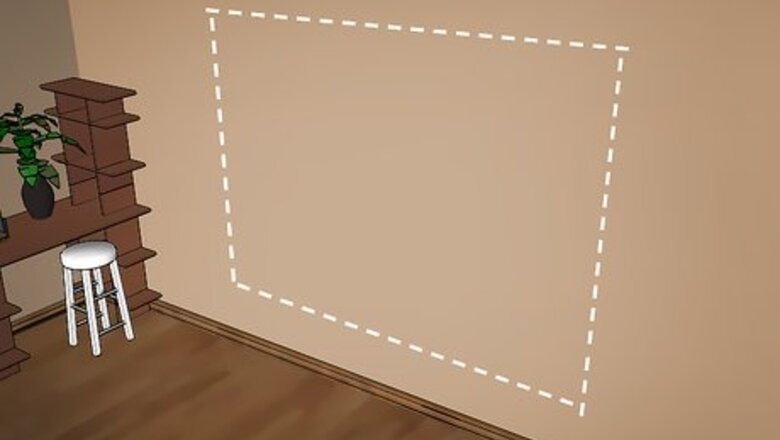
views
Preparing the Wall for Your Mirror
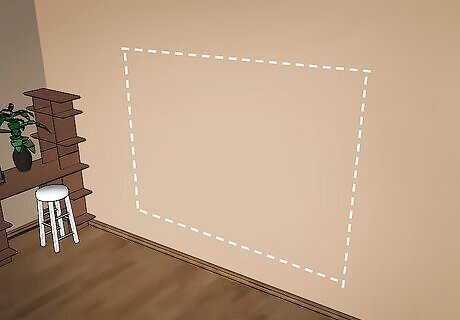
Choose where you want to mount the mirror. Pick a section of wall that's relatively free from clutter and large enough to accommodate the entire mirror with room to spare. You'll generally also want to hang mirrors high enough that people can look themselves in the eye as they walk by, though there are situations where you'd make an exception to this rule, such as if you want to hang a mirror over the mantle of a fireplace.
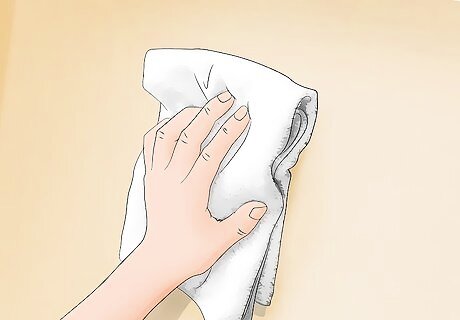
Clear the area in front of the wall where you'll be hanging your mirror. Make sure you have plenty of space to work around the area where you'll be hanging your mirror. Having a clear work space prevents you from tripping over furniture or any other items that may be in the way, which can be disastrous if your heavy mirror is an antique. You may also want to clean the wall itself if it's dirty. Heavy mirrors can, understandably, be hard to clean behind, so use this chance for cleaning before the mirror's on the wall. Set the mirror aside in a safe place to avoid damage while you're moving any furniture.
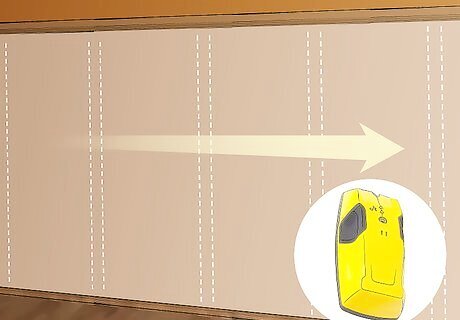
Use a stud finder to mark the edges of studs on the wall. Finding studs is a very important part of hanging a mirror. Behind most interior walls are evenly-spaced wooden support beams called studs. You need to make sure that the screws or nails you hang your mirror from are driven directly into the studs. Otherwise, they'll be supported by nothing but plaster and drywall, which won't be able to hold most heavy mirrors. Use an automatic stud finder (available for sale at nearly all hardware stores) to locate studs in your wall. Mark the outside edges of each stud in the area where your mirror will hang with a pencil. These marks will serve as your guide when you mount your mirror. If you're feeling confident and for whatever reason you can't use a stud finder, it's possible to approximate the location of studs by tapping on the wall. Use your index and middle finger to tap firmly (but not violently) on the wall and listen to the sound your tapping makes as you move back and forth. When you're tapping between studs, your taps should sound more "boomy" or "echo-y", while your taps should sound flat and dull over studs. Note that this method isn't nearly as accurate as using an actual stud finder.
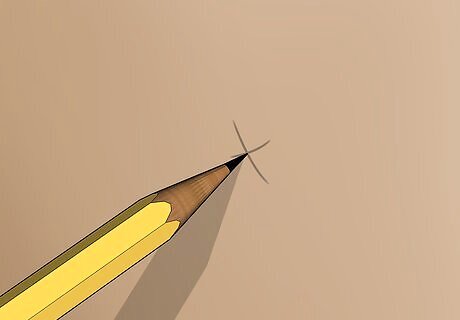
Use measuring tape to mark the center of each stud. Stretch a tape measure (or hold a ruler) between each set of pencil marks on the wall. Use this to find the center of each stud, marking with a pencil as you go. The center of the stud is the strongest, most stable place to hang your mirror from, so you'll want to mount your screws as close to the center of each stud as possible.
Using a Hanging Wire
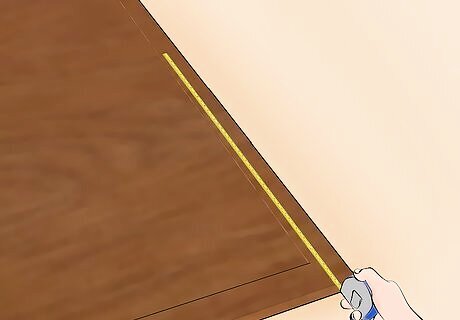
Use a tape measure to find the center of your mirror. Measure the length and width of your mirror - the middle points of these measurements, taken together, will give the exact center of your mirror. It's important to locate the exact center of your mirror so that you'll be able to accurately mount supports on the mirror's frame. It's also a good idea to carefully mark the center of each of your mirror's edges on the back of its frame.
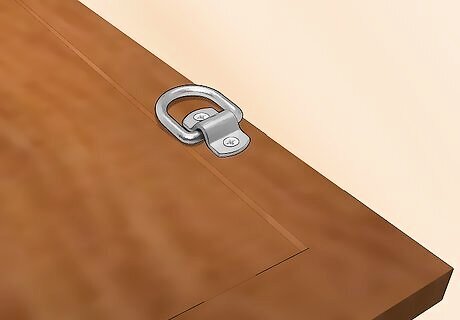
Install D-rings on the back of the mirror. Mark 2 spots about 6 inches (15.24 cm) from the top on either side of the center of the back of the mirror. Install two D-rings at these markings. These D-rings will guide the hanging wire once it's eventually installed, keeping it even and balanced.
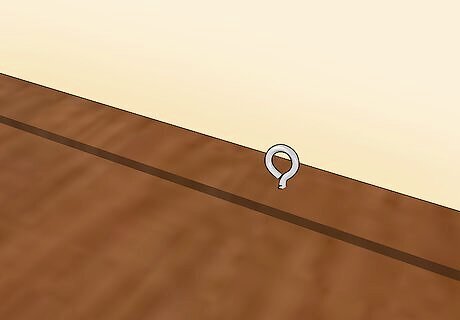
Install screw eyes near the bottom of the mirror. Mark two spots near the bottom of the frame, one on each side of the mirror's center.

Unwind a long length of sturdy metal wire. Double the wire and thread it through one of the screw eyes, up and through the D-rings, and then back down to the screw eye on the other side of the frame. Leave some slack in the wire, as it will eventually need to hang from a support mounted into the wall.
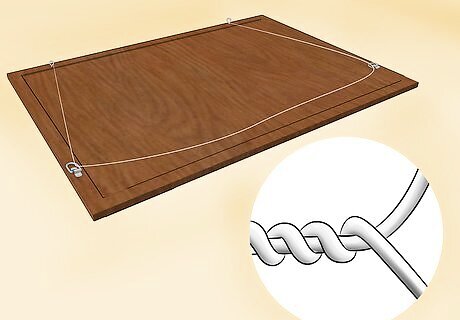
Use pieces of scrap wire to reinforce the hanging wire. Cut four medium-length lengths of wire. Wrap a length of scrap wire tightly around the hanging wire several times and crimping it closed with pliers, securing it to one of the screw eyes. Repeat for both spots where the wire connects with a D-ring.
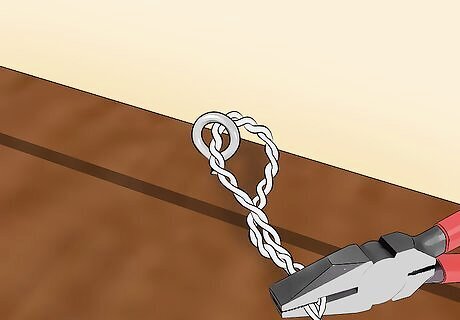
Make a final loop of the wire through the remaining screw eye. Cut and wrap the wire, securing it tightly. Crimp the wire closed with pliers.
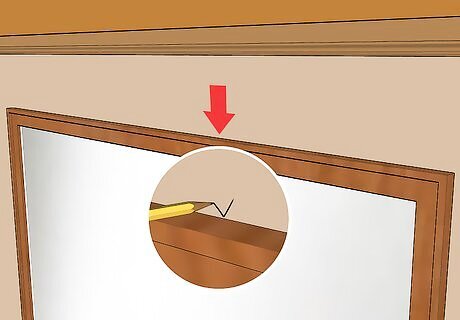
Gently lift the mirror to the desired position. Carefully use a free hand or get a friend to mark the wall at the center of the top of the mirror. Carefully lay the mirror back down in a safe place.
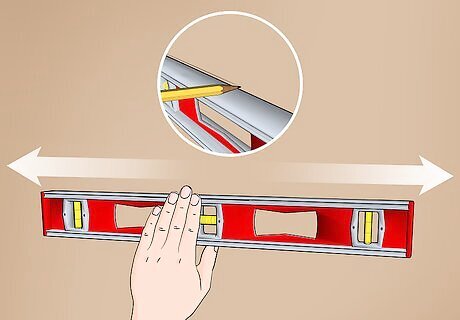
Use a level to draw a line across the wall. You want to draw a line on the wall that's exactly parallel to the floor - you'll use this line to judge whether your mirror is hanging straight or not. Position a level on the wall at the top-center mark you just made, then, when its bubble is perfectly positioned between the two lines in the horizontal tube, carefully draw a straight line along its edge.
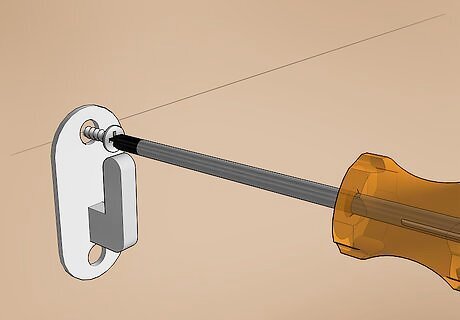
Draw lines along the center of two adjacent studs up to the top line. Find two studs that lie within the area your mirror will take up - the wider apart, the better, but they shouldn't lie outside the edges of your mirror. From the center of these studs, draw a straight line up to the top horizontal line. Mark a point approximately 4 to 5 inches (10.16 to 12.7 cm) from the top line along the center line of each stud. These points are where you will install your supports into the wall, so use a level to make sure these points are lined up horizontally.

Install hangers into the wall at the 2 positions just marked. Drive two heavy-duty hanging screws into the wall - one at each point you just marked. Use an automatic drill to bore a hole that's narrower than the hanging screws you've chosen at each mark, then use a screwdriver attachment to drive the screws in, making sure there's enough screw left protruding from the wall to catch the wire. Before installing your hanging screws, make sure they're rated to hold an amount of weight greater than the weight of the mirror. Keep in mind that the effective weight of your mirror can increase when you pull it away from the wall to clean under it. Not all hanging screws are the same. Defer to the advice of an experienced professional or the manufacturer's instructions included with your screws if you're unsure of how to safely install them. Alternatively, you may choose to use heavy-duty nails, as pictured.

Lift the mirror into position slowly and carefully. Catch the mirror's wire on the two hanging screws. Make sure the wire lays on both hangers securely, then slowly and gently let go of the mirror, allowing the screws to hold its weight.
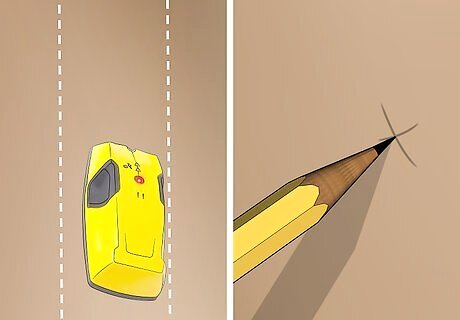
Adjust the mirror for straightness and clean up. Use the horizontal line on the wall and/or a level to fine-tune your mirror's position so that it hangs perfectly parallel to the floor. When you're done, carefully use an eraser to gently remove the lines you drew on the wall. Some home improvement sites recommend specialized cleaning products for removing pencil marks, particularly the "Magic Eraser" and other similar melamine foam sponges.
Using French Cleats

Prepare the wall as normal. This method uses a special type of mount called a french cleat to hang your mirror, rather than a hanging wire. However, it still uses the studs in the wall for support, so it's necessary to prepare the wall and mark the studs and their centers, so proceed through Part One above as normal, cleaning the surrounding area and carefully marking your studs.
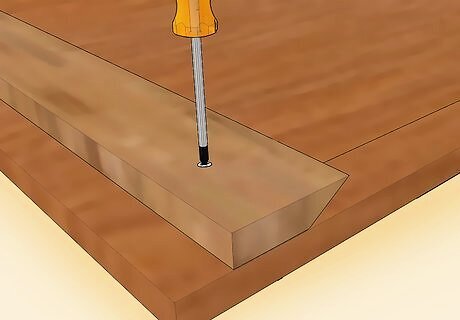
Buy or make a french cleat. French cleats are wide, notched supports made of wood (or sometimes metal) used for hanging heavy objects on the wall. They are usually available at most hardware stores - if you want to buy commercial cleats, look for a set that's rated for loads greater than that of the mirror you want to hang. However, if you have a suitable piece of wood and basic knowledge of woodworking, it's not hard to make your own. Follow the instructions below: Cut a sturdy piece of board that's about 3/4 of an inch thick so that its length is slightly shorter than the width of your mirror. Make a 30-45 degree beveled cut down the length of your board near its center. You should now have two pieces of wood, each with a wide face and a narrow face, and each with a slanted edge. These pieces of wood will fit together to create a sturdy hanging platform for your mirror.
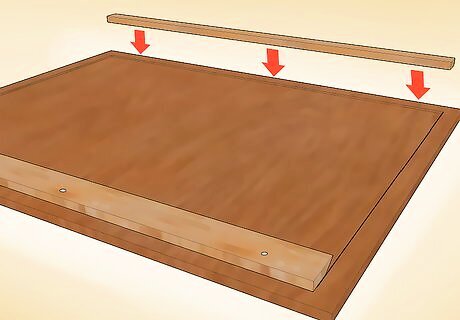
Attach one of the cleats along the top edge of the back of your mirror. Using strong glue or appropriate screws, fasten one of your cleats to the back of your mirror - usually this is the smaller of the two. Position the narrow face of the cleat just below the top edge of the mirror with the slanted edge pointing down. Use a level to ensure it's perfectly straight. This should create a downward facing "hook", which you'll eventually catch on the wall-mounted cleat to support the mirror. If using commercial cleats, defer to the manufacturer's instructions - however, the basic idea should be roughly the same - you want the "hook" of the cleat to point down so that it will catch on the cleat attached to the wall.
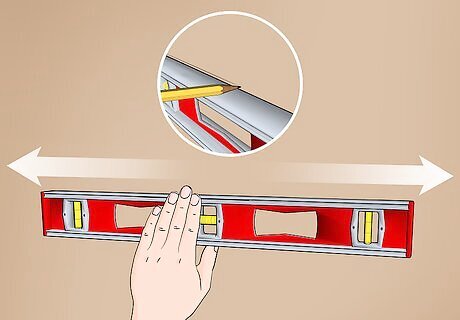
If necessary, attach an offset board to the bottom of the mirror. When the mirror is eventually seated in its cleat, its weight will be supported along its top edge. if there's nothing to support the bottom of the mirror, the weight of the mirror can cause it to "twist" towards the wall, damaging the mirror or tearing the cleat out of the wall. Because of this, it's important to ensure that the bottom edge rests flush against the wall. Attach a length of board that's the same thickness as the cleat to the bottom edge of the mirror. This is called an "offset board" - it supports the bottom of the mirror against the wall. If you plan to build your own mirror, one way to negate the need for an offset board is to fashion the upper edge of the mirror's wooden frame with a beveled edge so that it can act as a cleat itself.
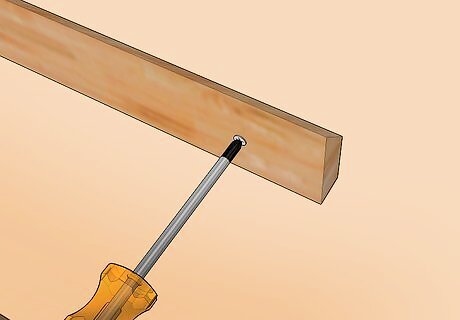
Mark the second cleat's position on the wall. The wall-mounted cleat (usually the larger of the two) needs to be securely mounted to the wall to ensure the mirror is well-supported. Use a level to draw vertical lines through the center of your studs, then use the level again to draw a horizontal line through these new lines at the precise height you want your cleat to sit. Mark each intersection of your stud center lines and your upper horizontal line - these locations are where you'll secure the cleat to the wall.

Attach the second cleat to the wall. Use sturdy wood screws (rated for a load greater than that of the mirror) to fasten the cleat to the wall, driving the screws through the wooden cleat and in to the centers of several studs. The cleat should be positioned so that its wide face points out from the wall and its slanted edge points up, creating an upward facing "hook." Again, if you're using a commercial cleat, defer to the manufacturer's instructions, but the general idea should be about the same.
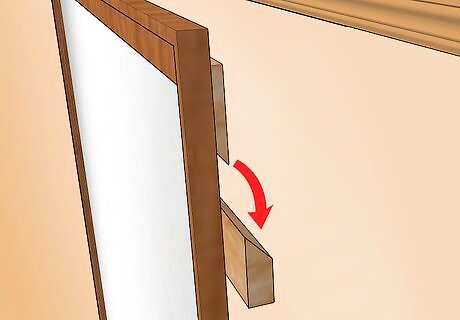
Hang the mirror. Lift the mirror into place and lock the two cleat "hooks" together. They should fit together like jigsaw pieces. Gradually reduce your hold on the mirror until it is fully supported by the cleat. Note - if you've used wood glue to secure the mirror's cleat, be sure to wait until the glue is completely dry before hanging the mirror. Even if you're 100% sure that the glue has dried, hang the mirror very gently and carefully. If possible, have a friend with you who can help you catch the mirror, should the glue prove to be of insufficient strength.




















Comments
0 comment